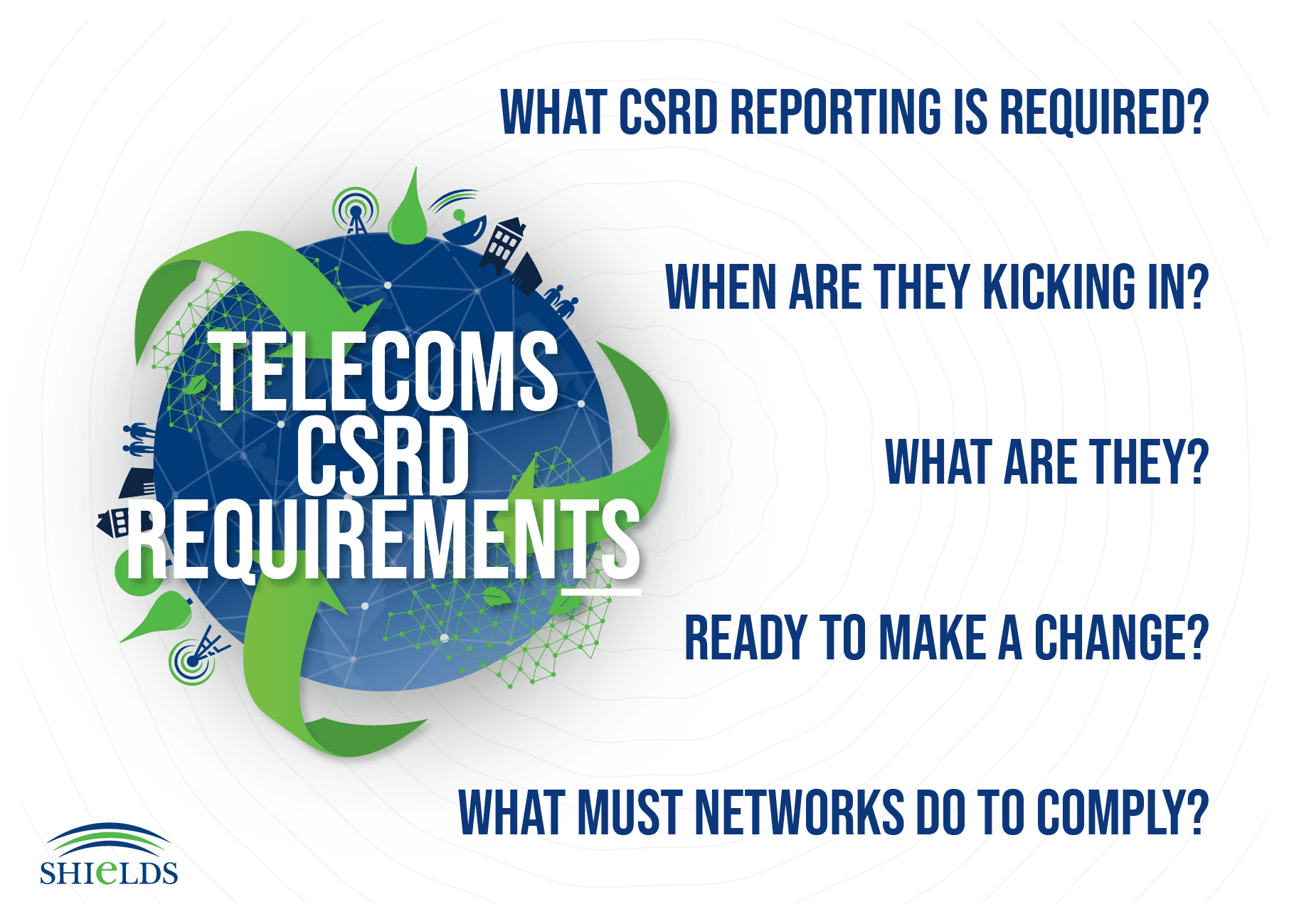What does the Corporate Sustainability Reporting Directive (CSRD) mean for the telecoms industry?
Looking for clarity about telecoms CSRD requirements for networks? You’re in the right place.
The telecoms industry has come a long way in recent years, connecting the world and making our lives more accessible than ever before. But with all that progress comes a unique challenge: minimising the environmental impact of our vast networks.
We’re living in an era where global environmental consciousness is on the rise. It’s no longer just a vague feeling that we ought to be more responsible stewards of our planet; we must actively demonstrate that we’re pursuing sustainability too.
Thanks to initiatives like the Global Reporting Initiative Standards and the Task Force on Climate-Related Financial Disclosures recommendations, some networks have been voluntarily reporting Environmental, Social and Governance (ESG) metrics for years.
But a new EU Directive has made it mandatory for most networks to disclose their contribution to the circular economy, changing the playing field for the entire industry. Introducing the Corporate Sustainability Reporting Directive (CSRD).
What is the Corporate Sustainability Reporting Directive (CSRD) and how will ESG reporting affect telecoms networks?
The Corporate Sustainability Reporting Directive (CSRD) came into effect for the 2024 financial year, and from 2025, it’s set to reshape how telecoms companies report their environmental performance.
Just like you’re required to submit annual financial reports, companies now have to disclose information for each reporting period, shedding light on their contribution to sustainability too.
The shift carries significant implications for networks:
- The volume of data that needs to be gathered will greatly increase
- Networks will need to involve more people in the reporting process
- Stakeholders will scrutinise ESG data just as closely as financial information
- You’ll need to present reports in a digital format (no surprises there!)
- Your ESG information must be auditable
- Your metrics must be backed up by third party assurance
That’s just the practical side, so what telecoms CSRD reporting is actually required?
What must telecoms networks report under the CSRD sustainability mandate?
The key processes that networks will need to report to comply with telecoms CSRD requirements include:
- Overall weight of products and materials used: This measure will help quantify the resources required to build and maintain the telecom infrastructure. It’s an essential step in understanding the environmental footprint of the industry.
- The weight and percentage of renewable materials used in manufacturing: Transitioning to renewable materials in telecom equipment manufacturing is a significant step toward reducing the industry’s carbon footprint. Reporting on this metric will push networks to be more sustainable.
- The weight and percentage of reused/recycled materials used: Reusing and recycling materials can significantly reduce waste and the need for new resources. This metric will encourage networks to adopt circular economy practices.
- The total amount of waste generated: Understanding the amount of waste generated will reveal the industry’s impact on landfills and overall sustainability.
- The amount of weight diverted from disposal of each type of waste: This will need to be split into all the different recovery types, e.g. preparation for reuse and for recycling.
When is telecoms CSRD mandatory ESG reporting kicking in?
Let’s talk about compliance with the new directive. The mandate is rolling out gradually from 2024 to 2029, and when your network will need to start complying depends on a few different things. Here’s the timeline you can expect:
- From the financial year 2024 (with reports due in 2025): Compliance is a must for organisations that were already under the Non-Financial Reporting Directive (NFRD) umbrella. That includes all companies listed on EU-regulated markets with 500 or more employees.
- Moving on to the financial year 2025 (reports due in 2026): Compliance becomes mandatory for any large companies that weren’t previously bound by the NFRD, as long as they have at least 10 employees, are turning over at least €700,000 and have €350,000 in total assets (e. most networks).
- In the financial year 2026 (with reporting due in 2027): SMEs listed on EU-regulated markets must comply if they meet at two of the following criteria: have at least €4m in total assets, generate at least €8m in net turnover, or have an average of at least 50 employees throughout the year.
- Starting in the 2028 financial year (reporting in 2029): Compliance is required for all EU subsidiaries of non-EU parent companies, where revenues total at least €150m in the two previous years and where the company owns another large EU-based company.
How can networks meet telecoms CSRD requirements and ensure reports are accurate and credible?
The good news is that Shields can provide you with the third party assurance and many of the metrics your network requires to support your CSRD reporting.
Our newly relaunched service, the GSMA Equipment Marketplace, enables you to track your environmental impact and see exactly how many CO2e
You can also visualise your network’s performance on a global scale, identify regions within your network where improvements could be made and optimise resource allocation to lower your impact.
Everything is digital, everything is auditable and everything is presented in a simple user-friendly interface.
The even better news is that simply by using GSMA Equipment Marketplace to source telecoms equipment, your network will get the quality assets it needs, while saving money, reducing waste and reusing more. To find out why more and more major networks are buying used telecoms equipment, click here.
How does GSMA Equipment Marketplace help networks meet telecoms CSRD requirements and lower their CO2 impact?
The GSMA Equipment Marketplace supports your telecoms CRSD reporting requirements and enhances your network’s sustainability at the same time. Here’s how:
- Definitive ESG reporting: Our reports dashboard gives you a clear view of your network’s ESG performance, and you can use the digital breakdowns to support your telecoms CSRD reports.
- Quality assets: When you source equipment through GSMA Equipment Marketplace, you’re not just ticking a box; you’re getting the quality assets your network needs to operate efficiently and reliably. Quality matters, and we ensure that your network gets nothing less.
- Reduce waste: By sourcing through GSMA Equipment Marketplace, you’re contributing to a reduction in waste generation. It’s win-win – you’re complying with the CSRD, saving a lot of CAPEX and OPEX, and you’re helping the environment too.
- Reuse and recycle: Embracing circular economy principles is more than just a buzzword; it’s a commitment to sustainability. GSMA Equipment Marketplace promotes the reuse and recycling of materials, reducing the demand for new resources and helping the planet in the process.
Create a free GSMA Equipment Marketplace account, here.
Ready to make a change, source more sustainably and fall in with the CSRD mandate?
If you haven’t already considered sourcing your telecoms equipment through GSMA Equipment Marketplace, now’s the perfect time to explore this opportunity – before the CSRD mandate kicks in and you fall behind.
By doing so, your network can adapt for CSRD requirements and reduce its Scope 3 emissions, decrease its CO2e impact, and cut down on costs. It’s a big green tick for your network and for the planet too.
If you’d like to decarbonise your supply chain and fast-track your network’s shift to net zero, start sourcing for free on GSMA Equipment Marketplace and see how many emissions (and pounds) you can save in this new era of global environmental consciousness.

